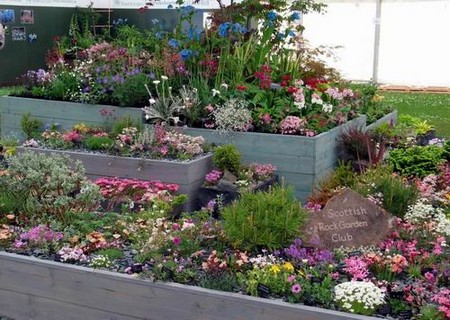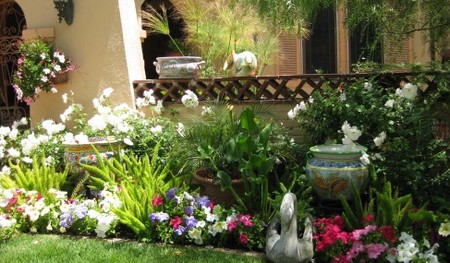The aims of designing a garden for a small space vary according to different needs. But the basic requirement must be to have something pleasant to look out on all year round. The garden should complement the house and the design should take into account the type of brickwork or facing, colour of paintwork and any special features such as a balcony or French windows. As well as thinking about the view from the ground floor also consider what it will look like when seen from the upper windows.
Most people want an area for sitting in and this will usually be in the sunniest part of the garden, not necessarily nearest to the house. Attractive garden furniture can be made into a feature and with only a small garden to look after you should have plenty of time to sit down and relax!

Barbecues are very popular and these can be built as a permanent feature rather than having a portable one that has to be stored somewhere. There will also be things that need to be hidden such as dustbins, garden tools and possibly a compost heap if you are very enthusiastic. Whether or not you have children or pets will influence the design and also how much time you will be spending in the garden. If there is a disabled person in the house their needs should be considered at the earliest planning stage.
Many people will want to go for low maintenance and this is easily achieved with a mixture of hard surfacing, shrubs and ground cover with the odd plant pot or ornament strategically placed. Once the plants have established themselves they will cover the soil and stop the weeds from growing. All that will need doing is a little feeding occasionally and some pruning to keep the shrubs in shape.
You don’t even need many plants to achieve a pleasing effect. Just a few climbers and two or three planted pockets of soil among the paving or some containers can often suffice. Choose plants with attractive foliage and which have different shapes.
If you like gardening you will probably want a mixture of evergreens, herbaceous plants and annuals. Because of limited ground space you need to ‘think vertically’ and one of the first jobs is to decide what climbers you want to grow. If the garden is overlooked it is important to get things growing quickly to supply privacy as soon as possible. It is also important to think about the aspect of the garden. Most small gardens and backyards are in the shade for the greater part of the day so any sunshine that filters through should be given a clear unimpeded run.
Whether you want a neat and tidy garden or a jumbled one, never be tempted to plant too much at the start. Although it will give an instant effect the plants will soon overcrowd each other and, as you only have a small space, you will not be able to move them to another part of the garden. A good idea is to plant the shrubs at a reasonable distance apart, bearing in mind the eventual spread, and fill in the gaps with annuals. The better the soil the quicker the plants will grow so if the ground is poor it will pay to buy in some good quality top soil or dig in plenty of compost, peat and fertilizer or manure before planting.
Hidden corners are always exciting and they can be created quite easily. The thing to avoid is lots of small, divided areas making it look too ‘twee’. A natural effect can be achieved by curving a path round a large bush or having an archway near the bottom of the garden so that you can’t quite see what is on the other side of it.
A focal point is a good idea to lead the eye to a certain part of the garden. A statue viewed through an archway or a fountain bubbling up through the undergrowth will catch the attention. Sometimes it is not easy to make things look natural and casual especially when the plants are young. But as they become established you will have more idea of the finished effect and any glaring mistakes can be remedied.

With an enclosed garden you will not have to pay as much attention to the surrounding area as you would with a more open aspect. Existing trees will probably be the main external features to influence the overall design and these should be taken into consideration when planning the garden.
A colour scheme is important so that flowers don’t clash and there is not a jumble of too many different colours. The whole garden could run on the same theme, for example green and silver foliage plants with pink, blue and white flowers. Yellows and white look good together and create a cheerful effect. It is the strong colours that are the most difficult to accommodate and they should be used with care to avoid a garish colour scheme. A lot of the modern hybrids are bred for their bright colours and double flowers and they often look too brash.